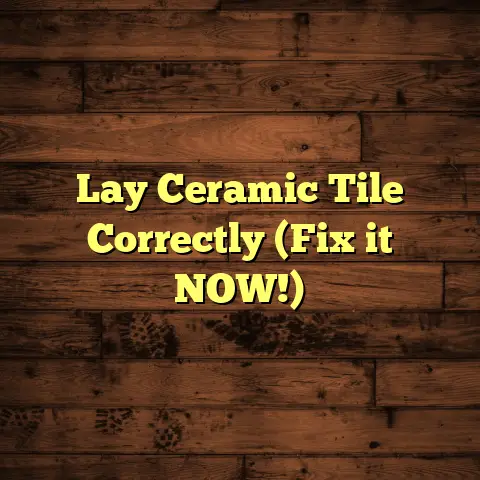Which Is More Expensive Hardwood Or Ceramic Tile? (Explained)
When I think about flooring choices for a home, resale value often comes to mind.
For homeowners looking to sell, the type of flooring can play a significant role in attracting buyers and influencing offers.
Among the most popular options are hardwood and ceramic tile, and both have their passionate advocates.
But which is more expensive?
I’ve had my fair share of experiences with both materials, and I’d love to share what I’ve learned along the way.
The Cost of Hardwood Flooring
In my early days as a flooring contractor, I worked on various homes, observing how hardwood floors could transform a space.
I recall one residential project in a suburban neighborhood where the homeowner opted for oak hardwood.
The material cost alone was around $8 to $12 per square foot, depending on the grade and finish.
With installation costs ranging from $3 to $8 per square foot, it quickly added up.
For a living room of about 300 square feet, the total cost of hardwood installation could easily reach $3,000 to $6,000.
The rich warmth of the wood certainly enhanced the aesthetic appeal, but I also noticed the maintenance challenges that came with it.
Homeowners had to be diligent about cleaning and refinishing every few years to keep the floors looking pristine.
The Cost of Ceramic Tile
In contrast, I remember a project where ceramic tile stole the show.
For a kitchen remodel in a downtown condo, the owner selected a beautiful, glossy white tile.
The cost for ceramic tile typically ranges from $1 to $5 per square foot, with installation costs around $4 to $10 per square foot.
For that kitchen space, about 200 square feet of tile resulted in a total cost between $1,000 and $3,000.
Unlike hardwood, ceramic tiles are resistant to moisture and scratches, making them ideal for high-traffic or wet areas.
This property was listed shortly after the renovation, and I was impressed by how quickly it sold—partly due to that stunning kitchen.
Comparing Installation Costs
When it comes to installation, both materials have their quirks.
Hardwood requires careful acclimatization before installation to prevent warping due to humidity changes, particularly in regions with fluctuating climates.
I’ve encountered issues where improper acclimation led to gaps between boards after installation, which was costly to rectify.
On the other hand, ceramic tile installations demand a solid subfloor and specific adhesive methods.
I once had to redo a tile job because the initial mortar mix wasn’t up to par, leading to cracking.
Both flooring types require skilled labor for proper installation, so it’s essential to factor in contractor expertise when considering costs.
Maintenance Considerations
Maintenance plays a crucial role in long-term costs.
Hardwood floors can be refinished multiple times over their lifespan—often 50 years or more—if cared for correctly.
However, they can be susceptible to scratches and water damage if not maintained properly.
I’ve seen clients invest in high-quality cleaners and protective coatings just to keep their wood looking flawless.
Ceramic tiles are generally easier to maintain.
A simple sweep and mop can keep them clean, and they don’t require any refinishing.
However, grout lines can be a pain; they often stain and need periodic sealing or cleaning.
In one of my projects, I had to use a specialized cleaner on grout that hadn’t been sealed properly—definitely an unexpected expense!
A Personal Experience with Cost Estimation
In my work as a contractor, I often rely on tools like FloorTally for accurate cost estimates and project management.
When planning a flooring project, FloorTally helps me input all necessary measurements and parameters quickly.
I remember preparing estimates for a large apartment complex renovation where both hardwood and ceramic were being proposed in different units.
Using FloorTally allowed me to visualize costs accurately based on local material prices and labor rates.
It saved me countless hours of calculations and ensured my clients received realistic budgets upfront.
No one likes surprises when it comes to spending!
Resale Value Insights
Now let’s circle back to resale value.
Research shows that homes with hardwood floors tend to sell faster and for higher prices than those with other types of flooring.
According to various studies, hardwood floors can increase a home’s value by 1% to 10%.
Personally, I’ve seen this firsthand; buyers gravitate towards homes with rich hardwood floors because they often see them as more luxurious.
Ceramic tiles also add value but typically don’t drive prices up as significantly as hardwood can.
They offer durability and aesthetic appeal but may not carry the same weight with buyers looking for that classic wood look.
Making the Right Choice
So which is more expensive?
Generally speaking, hardwood can appear pricier upfront, especially considering installation costs.
However, when you factor in longevity and resale value, it might be worth that initial investment.
Ceramic tile is cheaper initially but lacks some of the appeal that hardwood provides in terms of resale.
Tips for Choosing Between Hardwood and Ceramic Tile
- Consider Your Lifestyle: If you have pets or kids who are prone to spills, ceramic tile might be the better option due to its durability.
- Think About Aesthetics: Do you prefer the warmth of wood or the sleekness of tile?
Both have their unique charm. - Evaluate Maintenance: Are you ready to put in the effort for hardwood maintenance?
If not, go with ceramic. - Plan for Resale: If you plan on selling soon after installation, consider which material appeals more to your target buyer demographic.
Final Thoughts
Choosing between hardwood and ceramic tile isn’t merely about cost; it’s about understanding what fits best for your home and lifestyle.
Each material has its strengths and weaknesses, so weigh your options carefully before making a decision.
Whether you go with the classic appeal of hardwood or the practicality of ceramic tile, ensure it aligns with your budget, needs, and future resale plans.
After all, flooring is more than just a surface—it’s an investment in your home’s future!
As we dive deeper into this topic, let’s explore more aspects that influence cost and choice between hardwood and ceramic tile.
The Aesthetic Appeal of Hardwood vs Ceramic Tile
One significant factor in choosing between hardwood and ceramic tile is aesthetics.
Hardwood floors provide a timeless elegance that many homeowners adore.
The natural grains and textures create warmth and character in a space.
In my experience, homes with hardwood flooring often feel inviting and cozy—a trait that many buyers appreciate when they walk through the door.
I remember working on a historic home renovation where we restored original oak flooring from the 1920s.
It was an arduous process requiring careful sanding and refinishing, but the end result was stunning!
The beauty of those aged boards captivated everyone who entered.
On the flip side, ceramic tiles come in various designs, colors, and finishes that can mimic natural stone or even wood grain.
This versatility means you can achieve different looks without sacrificing durability.
For instance, during another project for a modern loft, we installed large-format tiles that resembled reclaimed wood—an excellent solution for homeowners wanting that rustic feel while maintaining easy upkeep.
Environmental Considerations
Another aspect worth considering is environmental impact.
Hardwood is a natural product sourced from trees; however, not all hardwood is sustainably harvested.
As a contractor committed to eco-friendly practices, I always recommend clients look for certifications like FSC (Forest Stewardship Council) when sourcing hardwood materials.
This certification ensures that the wood comes from responsibly managed forests.
Ceramic tiles are made from clay and other natural materials; however, their production process can be energy-intensive.
On one occasion, I worked with a supplier who offered eco-friendly ceramic tiles made from recycled materials—this option appealed to environmentally conscious clients and provided them with unique design choices.
Durability Comparison
Durability is another critical factor when comparing these two flooring options.
Hardwood floors can last decades if properly maintained but are susceptible to scratches and dents from heavy furniture or pet claws.
In one home where I installed hardwood flooring, I noticed some wear within just a few months due to high foot traffic without adequate protective measures in place.
Ceramic tiles are incredibly durable and resistant to moisture, making them ideal for kitchens and bathrooms.
They can withstand heavy foot traffic without showing signs of wear quickly.
During one project where we used large porcelain tiles in a commercial space, we were impressed by how well they held up despite being under constant use.
Climate Considerations
Climate can also influence your choice between these two materials.
In humid regions or areas prone to moisture exposure, ceramic tiles may be the better option due to their water resistance.
During my time working near coastal areas, I often recommended tile flooring for homes close to the beach where humidity levels were high.
Conversely, in colder climates where heating systems may lead to dry air conditions, hardwood floors can adapt well if properly acclimatized before installation.
It’s important to consider how each material will react to your local climate conditions when making your choice.
Cost Variability Based on Location
One aspect that often surprises homeowners is how location impacts flooring costs.
Living in an urban area versus a rural one can result in significant price differences due to labor availability and material costs.
For instance, I’ve seen hardwood prices soar in cities where demand exceeds supply—sometimes reaching upwards of $15 per square foot for premium species like walnut or cherry.
In contrast, ceramic tiles generally maintain more consistent pricing across locations due to their mass production availability; however, unique designer tiles might still carry a hefty price tag depending on their origin or craftsmanship.
Installation Challenges
Both flooring options present specific installation challenges that can affect overall costs.
With hardwood flooring, proper acclimatization is crucial before installation—a process that may take several days depending on humidity levels—an aspect some homeowners overlook when estimating timelines.
Ceramic tile installations require precise leveling of subfloors along with careful planning around patterns (e.g., diagonal layouts) which can lead to increased labor costs if not planned adequately upfront.
Cost Breakdown with FloorTally
To illustrate further how software like FloorTally aids in managing these complexities: during one particular project involving both hardwood and ceramic tile installations across multiple rooms within different timelines—I was able to use FloorTally effectively by breaking down each room’s requirements individually.
By inputting dimensions for each area along with specific material selections (including waste factors), I generated comprehensive estimates quickly while avoiding costly mistakes associated with miscalculations or oversights—a benefit that has saved me time on numerous jobs.
Long-Term Value Assessment
Let’s discuss long-term value assessment regarding both materials.
While initial installation costs may seem higher for hardwood due largely because of premium pricing—over time its resale value often compensates significantly given its appeal among potential buyers compared against slightly lower-cost ceramic counterparts.
When assessing potential return-on-investment (ROI), it’s essential also consider maintenance expenses involved throughout ownership; while ceramic may alleviate immediate upkeep concerns—investing wisely into quality hardwood could yield dividends later upon selling your property!
What Buyers Are Looking For
Understanding what buyers seek during their home search plays an integral role when deciding between these two options as well!
Many prospective homeowners prioritize aesthetics over practicalities—they want something visually stunning that complements their lifestyle choices—this is why hardwood continues commanding attention even amidst rising popularity surrounding ceramics!
I’ve witnessed firsthand many buyers walk into homes featuring well-maintained wood floors immediately envisioning themselves living there—this emotional connection proves invaluable upon making an offer!
Practical Installation Tips
Here are some practical tips gathered from my years in this industry:
- Plan Ahead: Always measure twice before buying materials—one miscalculation could lead down an expensive rabbit hole!
- Choose Quality: Invest in high-quality materials rather than opting for bargain deals—often cheaper options lead straight into costly repairs down the line.
- Hire Professionals: While DIY projects sound appealing—it pays off significantly hiring experienced professionals (like myself!) who understand intricacies involved—this saves time & frustration!
- Consider Traffic: Evaluate foot traffic levels within each room when selecting your floor type; more durable surfaces should be prioritized where footfall is highest!
- Regular Maintenance: Establish routine cleaning schedules early on; whether utilizing specialized products for hardwoods or simple mopping solutions for tiles—it prevents long-term issues from arising unexpectedly!
- Don’t Skimp on Underlayment: Proper underlayment ensures stability & sound absorption across both types while helping maintain temperature consistency too!
- Keep Up with Trends: Stay informed about current design trends!
Knowing what’s popular can help guide decisions toward choices likely appealing future buyers too!
Conclusion
Choosing between hardwood and ceramic tile involves considering various factors—from initial costs through maintenance requirements all while keeping resale values at heart!
As someone deeply entrenched within this industry—I urge everyone weighing these options carefully assess priorities before diving headfirst into installations!
Whether leaning toward timeless elegance offered by rich woods or opting for practical yet stylish ceramics—the right choice ultimately hinges upon personal preferences alongside lifestyle considerations shape outcomes long-term!
By leveraging tools like FloorTally alongside industry knowledge gained over years—you’ll navigate these waters much more seamlessly ensuring investments made today pay off tomorrow!





